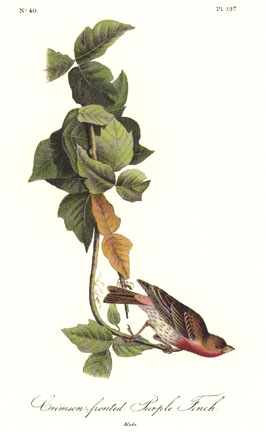

197 CRIMSON FRONTED PURPLE FINCH
| This species was first described under the name of Fringilla
frontalis, by Mr. THOMAS SAY, who discovered it in the course of LONG's
Expedition to the Rocky Mountains. It was afterwards figured and
described in the continuation of WILSON's American Ornithology, by the
Prince Of MUSIGNANO, who then considered it as belonging to the genus
Pyrrhula, but who has since placed it in a small group, to which he gave
the generic appellation of Erythrospiza. It is very closely allied, not
only in colour, but in size and form, to the Purple Finch, Erythrospiza
purpurea, with which one might at first sight readily confound it, but
from which it differs in having the bill somewhat more bulging, with
convex outlines, and in several other characters, such as the more
elongated and less emarginate tail. For the specimen from which the
figure has been taken I am indebted to Mr. GOULD of London. It is
reported to be from California. I have not met with this species, and,
in as far as I know, its habits have not been described.
Male, 6 1/4, wing, 3 1/2. Bases of the Rocky Mountains. Rare. Migratory. FRINGILLA FRONTALIS, Say, Long's Exped., vol. ii. p. 40. CRIMSON-NECKED BULLFINCH, Pyrrhula frontalis, Bonap. Amer. Orn., vol. i. pl. 1. CRIMSON-FRONTED BULLFINCH, Pyrrhula frontalis, Nutt. Man., vol. i. p. 534. CRIMSON-NECKED FINCH, Pyrrhula frontalis, Aud. Orn. Biog., vol. v. p. 230. Adult Male. Bill shortish, robust, bulging, conical, pointed; upper mandible with the dorsal outline a little convex, the back and sides rounded, the edges direct, overlapping, slightly arched, with a faint sinus, and a little deflected at the base; lower mandible with the angle short and wide, the dorsal line ascending and very slightly convex, the back and sides convex, the edges sharp and inflected. Nostrils basal, roundish, open, partially concealed by the feathers. Head rather large, broadly ovate; neck short; body full. Feet of moderate size; tarsus slender, compressed, covered anteriorly with seven large scutella, of which the upper are rather indistinct, laterally with two long plates meeting so as to form a very sharp edge; toes scutellate above, free, the lateral nearly equal. Claws slender, arched, much compressed, acute. Plumage soft and blended, the wing-coverts compact. Wings of moderate length, the third primary longest, the fourth scarcely shorter, the second less than one-twelfth shorter than the third, and exceeding the first by one-twelfth. Tail long, broad, emarginate and divaricate, the middle feathers only a twelfth and a half shorter than the longest, which is the third from the lateral, the latter being of the same length as the middle. Bill brown above, paler beneath. Iris brown. Feet and claws light brown. Forehead and a band over the eye, proceeding down the neck, crimson; throat, fore part of breast and sides, with the rump, rich carmine, the latter paler. The upper parts greyish-brown, the head, hind neck, and fore part of the back slightly tinged with red; quills, coverts, and tail-feathers dusky and edged with pale brownish-grey, the first row of small coverts rather conspicuously tipped with a lighter tint of the same. Short bristly feathers at the base of the bill greyish-yellow; loral space and ear-coverts, light grey; the hind part of the breast, abdomen, and lower tail-coverts yellowish-white, streaked with dusky. Length to end of tail 6 1/4 inches; bill along the ridge (4 3/4)/12, along the edge of lower mandible (5 1/2)/12; wing from flexure 3 1/2; tail 3 1/4; tarsus 8/12; hind toe (3 1/2)/12, its claw (2 1/2)/12; middle toe (6 1/2)/12, its claw 2/12.
|